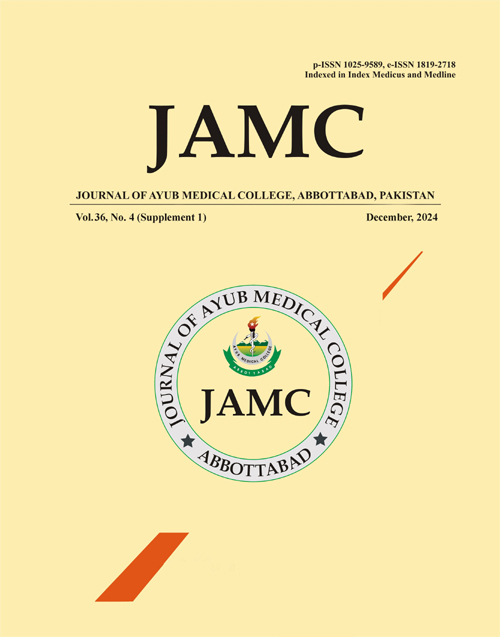ONE- VERSUS TWO-LAYER CLOSURE AT CESAREAN BIRTH
DOI:
https://doi.org/10.55519/JAMC-S4-14764Keywords:
Cesarean section; Uterine closure; One-layer technique; Two-layer technique; Surgical outcomes; postoperative complicationsAbstract
Background: Cesarean delivery is one of the most commonly performed surgical procedures worldwide. The technique of uterine closure plays a significant role in postoperative recovery and future reproductive outcomes. However, the optimal method of uterine closure whether one-layer or two-layer remains a subject of ongoing debate, particularly regarding uterine healing, surgical complications, and maternal outcomes. This study aimed to compare the clinical outcomes of one-layer versus two-layer uterine closure techniques following cesarean birth. Methods: This comparative observational study was conducted at Bilawal Medical College, LUMHS Jamshoro, from October 2021 to September 2022. A total of 100 women who underwent cesarean sections were included. Participants were divided into two comparable groups based on the uterine closure method: Group A received one-layer closure, while Group B underwent two-layer closure. Outcomes analyzed included operative time, estimated blood loss, postoperative pain, febrile morbidity, and wound complications. Results: The operative time in the one-layer closure group was significantly shorter than in the two-layer group (p<0.05). Both groups showed comparable results for estimated blood loss, febrile morbidity, and wound complications. The one-layer group reported slightly lower postoperative pain scores, though the difference was not clinically significant. Conclusion: One-layer uterine closure resulted in a shorter operative time without increasing the risk of short-term postoperative complications. This technique appears to be a safe and efficient alternative to the standard two-layer closure for cesarean delivery. Further research is needed to assess its long-term effects on uterine integrity and future pregnancies.
Medical College, Liaquat University of Medical and Health Sciences Jamshoro-Pakistan
Background: Cesarean delivery is one of the most commonly performed surgical procedures worldwide. The technique of uterine closure plays a significant role in postoperative recovery and future reproductive outcomes. However, the optimal method of uterine closure whether one-layer or two-layer remains a subject of ongoing debate, particularly regarding uterine healing, surgical complications, and maternal outcomes. This study aimed to compare the clinical outcomes of one-layer versus two-layer uterine closure techniques following cesarean birth. Methods: This comparative observational study was conducted at Bilawal Medical College, LUMHS Jamshoro, from October 2021 to September 2022. A total of 100 women who underwent cesarean sections were included. Participants were divided into two comparable groups based on the uterine closure method: Group A received one-layer closure, while Group B underwent two-layer closure. Outcomes analyzed included operative time, estimated blood loss, postoperative pain, febrile morbidity, and wound complications. Results: The operative time in the one-layer closure group was significantly shorter than in the two-layer group (p<0.05). Both groups showed comparable results for estimated blood loss, febrile morbidity, and wound complications. The one-layer group reported slightly lower postoperative pain scores, though the difference was not clinically significant. Conclusion: One-layer uterine closure resulted in a shorter operative time without increasing the risk of short-term postoperative complications. This technique appears to be a safe and efficient alternative to the standard two-layer closure for cesarean delivery. Further research is needed to assess its long-term effects on uterine integrity and future pregnancies.
References
1. Niino Y. The increasing cesarean rate globally and what we can do about it. Biosci Trends 2011;5(4):139–50.
2. Pavithra H. A comparative study of single layer versus double layer closure of uterus in lower segment caesarean section (Master’s thesis). Bangalore (India): Rajiv Gandhi University of Health Sciences
3. Roberge S, Demers S, Berghella V, Chaillet N, Moore L, Bujold E. Impact of single- vs double-layer closure on adverse outcomes and uterine scar defect: a systematic review and meta-analysis. Am J Obstet Gynecol 2014;11(5):453–60.
4. Sholapurkar SL. Etiology of cesarean uterine scar defect (niche): detailed critical analysis of hypotheses and prevention strategies and peritoneal closure debate. J Clin Med Res. 2018;10(3):166.
5. Daltveit AK, Tollånes MC, Pihlstrøm H, Irgens LM. Cesarean delivery and subsequent pregnancies. Obstet Gynecol. 2008;111(6):1327–34.
6. Johnson NP, Selman T, Zamora J, Khan KS. Gynaecologic surgery from uncertainty to science: evidence-based surgery is no passing fad. Hum Reprod 2008;23(4):832–9.
7. Wilson RD, Caughey AB, Wood SL, Macones GA, Wrench IJ, Huang J, et al. Guidelines for antenatal and preoperative care in cesarean delivery: enhanced recovery after surgery society recommendations (part 1). Am J Obstet Gynecol 2018;219(6):523.e1.
8. Ansaloni L, Brundisini R, Morino G, Kiura A. Prospective, randomized, comparative study of Misgav Ladach versus traditional cesarean section at Nazareth Hospital, Kenya. World J Surg 2001;25(9):1164–72.
9. Jyoti SG. A randomized study comparing non-closure and closure of visceral and parietal peritoneum during cesarean section [Master’s thesis]. Bangalore (India): Rajiv Gandhi University of Health Sciences.
10. Tanos V, Toney ZA. Uterine scar rupture—prediction, prevention, diagnosis, and management. Best Pract Res Clin Obstet Gynaecol 2019;59:115–31.
11. Ahmed Z. Primary port scar-Veress technique (closed): a better cosmetic result in comparison to Hasson’s technique (open) in creating pneumoperitoneum for laparoscopic surgeries in general surgery [Master’s thesis]. Bangalore (India): Rajiv Gandhi University of Health Sciences.
12. Sholapurkar SL. Etiology of cesarean uterine scar defect (niche): detailed critical analysis of hypotheses and prevention strategies and peritoneal closure debate. J Clin Med Res 2018;10(3):166.
13. Peters A, Ali R, Miles S, Foley CE, Buffie A, Ruppert K, et al. Two-layer compared with one-layer vaginal cuff closure at the time of total laparoscopic hysterectomy to reduce complications. Obstet Gynecol 2021;138(1):59–65.
14. Stegwee SI, Jordans IP, Van Der Voet LF, Bongers MY, De Groot CJ, Lambalk CB, et al. Single- versus double-layer closure of the caesarean (uterine) scar in the prevention of gynaecological symptoms in relation to niche development the 2Close study: a multicentre randomised controlled trial. BMC Pregnancy Childbirth 2019;19(1):85.
15. Norwitz ER, Snegovskikh VV, Caughey AB. Prolonged pregnancy: when should we intervene? Clin Obstet Gynecol 2007;50(2):547–57.
Published
How to Cite
Issue
Section
License
Copyright (c) 2024 Maryam Phulpoto, Jabeen Atta, Roohi Nigar, Zubair Ahmed Yousfani, Muhammad Hanzala Yousfani, Noor ul Ain

This work is licensed under a Creative Commons Attribution-NoDerivatives 4.0 International License.
Journal of Ayub Medical College, Abbottabad is an OPEN ACCESS JOURNAL which means that all content is FREELY available without charge to all users whether registered with the journal or not. The work published by J Ayub Med Coll Abbottabad is licensed and distributed under the creative commons License CC BY ND Attribution-NoDerivs. Material printed in this journal is OPEN to access, and are FREE for use in academic and research work with proper citation. J Ayub Med Coll Abbottabad accepts only original material for publication with the understanding that except for abstracts, no part of the data has been published or will be submitted for publication elsewhere before appearing in J Ayub Med Coll Abbottabad. The Editorial Board of J Ayub Med Coll Abbottabad makes every effort to ensure the accuracy and authenticity of material printed in J Ayub Med Coll Abbottabad. However, conclusions and statements expressed are views of the authors and do not reflect the opinion/policy of J Ayub Med Coll Abbottabad or the Editorial Board.
USERS are allowed to read, download, copy, distribute, print, search, or link to the full texts of the articles, or use them for any other lawful purpose, without asking prior permission from the publisher or the author. This is in accordance with the BOAI definition of open access.
AUTHORS retain the rights of free downloading/unlimited e-print of full text and sharing/disseminating the article without any restriction, by any means including twitter, scholarly collaboration networks such as ResearchGate, Academia.eu, and social media sites such as Twitter, LinkedIn, Google Scholar and any other professional or academic networking site.










